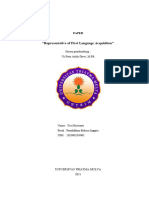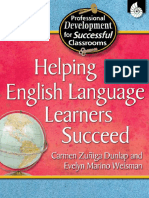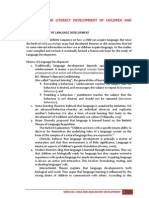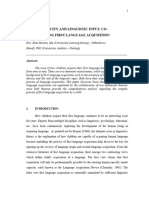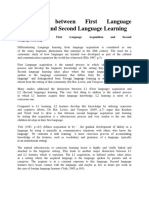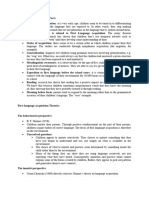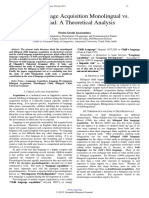Makalah Sla
Makalah Sla
Uploaded by
isnawitamCopyright:
Available Formats
Makalah Sla
Makalah Sla
Uploaded by
isnawitamOriginal Title
Copyright
Available Formats
Share this document
Did you find this document useful?
Is this content inappropriate?
Copyright:
Available Formats
Makalah Sla
Makalah Sla
Uploaded by
isnawitamCopyright:
Available Formats
SECOND LANGUAGE ACQUISITION
"Language acquisition does not require extensive use of conscious grammatical rules, and does not require tedious drill." (Stephen Krashen 2007) I. INTRODUCTION Language acquisition has been a major topic of research in linguistics for several decades with several reasons and various analyze. Children language acquisition is one interesting topic for linguistik researcher under the reason like the way of language acquisition in human is uniqueand could not approve only with one theory. Therefore nowadays there are some research written to prove the best theory in language acquisition. Undeniable that linguistic system mastered by children in informal lesson. ...learning a first language is something every child does successfully, in a matter of a few years and without the need for formal lesson. (language acquisition:on line:2011). From this statement we can conclude that laguage acquisition especially in first language children may began to acquire their language in family arrounded. Furthermore in children language acqui sition process, function of communication directed than
grammar. In the other word children language acquisition is one of the children growth process to be a member of family and society. Language simplify children to expressing their wish and ideas in the right way. Language acquisition will different in diffrent age of human. Therefore todays there are researches that explain about the differences between children's and adults' acquisition of first and second languages, some discuss about the approaches of it, even there some research that talking about the motivation in language acqusition of first and second language acqusition. All of this research can help us in studying or teaching first and second languages.
As we know that second language acquisition, or sequential language acquisition, is learning a second language after a first language is already established. Many times this happens when a child who speaks a language other than English goes to school for the first time. Children have an easier time learning a second language, but anyone can do it at any age. It takes a lot of practice. Fuirthermore there are some factors that influenced in second language acqusition to simplify the learner to acquire language, like intelligence, aptitude, motivation, attitudes, and age (Nunan Spada:1999:49). Almost every human child succeeds in learning language. As a result people often tend to take the process of language learning for granted. To many, language seems like a basic instinct, as a simple as breathing or blinking. But language is not simple at all, in fact it is the most complex skill that a human being will ever master. That nearly all people succeeded in learning this complex skill demonstrates how well language has adapted to human nature. In a very real sense, language is the complete expressions of what it means to be human. Today many people are attempting to master more than one language. It is undeniable that acquiring two or more languages may gain some benefits. Being a bilingualist or multilingualist would imply social and economical advantages. They would be commonly regarded as a group of people that has higher social status since the acquisition of other language requires a tremendous effort. A part from that, this skill may bring on an
income or extra income if the possessors apply it in particular occupations such as interpreters, translators, or language teachers. For those reasons above, in first and
second language acquisition, learning more about the theories, factors and approaches in language acquisition is need ed by any age of human in this world.
II. DISCUSSION 1. Learning a first language Human in developing their language competence has two kinds of way, language acquisition and language learning . Acquisition is a subconcious process, as well as a child learn their language. While language learning has opposite term in order to develop language, it concern on the grammar of its language. On the other side, language learning is refers to conscious knowledge toward L2 by knowing the rules of language (grammar) and having conciousness and realizing the ability to speak. (Guat:2006). Therefore, the process of language learning can be distinguishable from learning about language. there are characteristics of the language of young children and several theories which have been offered as explanations for how language is learned. (Nina Spada:1999). a. Milestones and patterns in development Children tend to produce their first words sometime between nine and twelve months. One-year-olds have about one or two words in their vocabulary on average, although individual children may have none or as many as thirty; by two years of age, average vocabulary size is fifty (50) different words or more. In this they can produce a simple sentence. Although the sentence is not complete yet but it has a meaning. This sentence sometimes named telegraphic. In three year old children can separated the true or false word even they can share jokes with people arounded them. b. Negation Children by three years of age began to identify the function of negation, like; deny, reject, disagree with, and refuse something. In the first stage they expressing their negative feeling by the word no or in sentence they can say No go, No cookie. No comb hair. For the second stage they can expressing their negation like Any bath!. On the third stages children can produce another expression of no become cant and dont. For example I cant do it. He dont want it. Finaly on the fourth stage, children start their sentence with using
auxiliary verbs like you didnt have supper. She doesnt want it. In order to achieve such a vocabulary in speaking, a child must learn to say at least a few new words each day from birth. 2. Theoritical approaches to explaining first language learning
a.
Behaviourism B.F. Skinner (1904-1990) claimed that language is just another form of behavior. It is a response to stimuli in the environment and it is learned. According to this view, commonly manners seem as human attitude therefore learning language must doing with stimulation from learner environment. (Nina Spada:1999:9) argues that behaviorists believed that language learning is the result of imitation, practice, feedback on success, and habit formation. Furthermore she said that the behaviourists view imitation and practice as primary process in language development. In the other word, learner quality in language learning is depend on what are they received from their environment.
b.
Innatism According to hand out of Mr. Imam G in Psycholinguistic : 8 said: The theory claims that every child was born with some innate capacities, one of which is specially used to process languages. It means the nature of language learning is different from learning other fields. This specific capacity consists of underlying abstract representation or rules or grammar, which is also called univesal rules of language or more popularly called universal grammar (UG). This consists of a set of potential rules that becomes materialized (mastery of language rules) after they get (largely subconscious) exposure of
language input. Furthermore Noam Chomsky in Nina Spada : 1999 claims that children are biologically programmed for language and that language develops in the child just the same way that other biological functions develop. It means that this theory is contradictive with behaviourism view, so they named their view as Nativism. This view claimed that every child born with language
acquisition device. McNeil (brown:1980:22) stated that Language Acquisition Device is consist of; a) competence in differences fonologi and fonem, b) linguistic competence, c) knowledge of language system , d)competence to use the language system. To conclude that Chomsky argues that children will acquire their language naturaly because of the biological endowment in human being. And its not depend on th e environment.
c.
The interactionist position Interaction is the third theoritical view of first language acquisition. this view believes that language acquisition is the result of interaction between
characteristic of learner and language environment. Its mean that interaction of both view cannot be separated in language acquisition because its relate with learner competence and the other. Van Els in (Yulianto:2007:24) called this procedural approach, in its interaction between internal and external factor is the point. The basic of this approach is child congnitive competence to find out the language structure around them. Furthermore Dardjowidjojo in (Yulianto :2007) said that nature and nurture influenced children language acquisition. from those emipirical approach, we can say that to reach the language learning and first language acquisition, intergrated the approaches above will simplify the learner. Its all appropriate in language leraning point of view to see the approach. 3. Theoritical approaches to explaining second language learning a. Learner characteristics Second language acquisition theory may help explain the puzzling situation of children and adults in learning language. To acquire second language means that learners have a first language already. This language as knowledge of other language can assist learners to be an accurate gusses in second language leraning process. But it could not happen to young language leraners at all because their cognitive maturity, metalinguistic awareness, and knowledge of the world is does not same like adolecent and adults have. In practice the language and its only depend on each
young learners is superior than adolencent and adults. They try to use the second language without nervous feeling, even they feel enjoyable to try their new language. While adult and adolescent can not do as well as youngers because they were afraid to make mistakes. This feeling is effected by human
emotion. Therefore m any researchers have described the importance of
emotion in the learningprocess and in the construction of meaning. Emotions and thoughts cannot be separated,and thus emotions have a great effect on all learning. Caines (1997). b. Learning condition Freedom to be silent is allowed to young second language learning. But for adult and adolencent is not. They must to practice their second language in daily life, like shopping, medical visits, or job interview. To developing their second language. In language learning children have ample time to practice their new language while adults and adolescent has not enough time to do. This condition need strategy from learners to adjust their time. The next learning condition is corrective feedback in grammar and pronunciation. This feedback is needed in learning to correct someone in using language. Feedback is the final step of the trial-and-error process of learning, but it's also an extremely important condition. (Neal in basic condition for learningl:2011). The next corrective feedback is word choice, it is needed in adults and adolescent learner. Although there is no classroom applied this feedback yet but teacher can try to do this in formal situation. The point is without feedback students don't have anything to judge what they know against. c. Behaviorism Behaviourism in first language has no significant differences with in second language. Behaviourists account for learning in terms of imitation, practice, reinforcement or feedback on success, and habit formation. (Nina
Spada:1999:35). Similar to first language approach, behaviourist stipulated that All learning works in the same basic process whether verbal or non verbal.
Environment contribute linguistic knowledge for learner to stimulate them in speaking correctly. Beside that this approach views that language development is a formation of habits, learners good habit in first language learning can help them in second language learning. A person language learning which involve his/herself in native language society will attain the target language easier than the other did not. Learner can correction their error pronunciation or grammar through the inreaction with people around them. This situation is good for learner in any age and best for children. (Pearson : 2006) argues that children absorb languages effortlessly and are adept imitators of speech sounds. Because they are very selfcentered, they do not work well in groups, and they respond best to activities and learning situations relating to their own interests and experiences. It means that in second language learning with real situation
or in native language community children can acquire the language in fast than adult and adolescent learner, because a lthough children have a
short attention span, they have great patience for repetition of the same activity respond well to concrete experiences and to large-motor involvement in language learning. d. Innatism In first language acquisition theory about innatism some linguists agreed that Universal Grammar offers the best perspective from which to undersatand second language acquisition. But the other say that in second language acquisition universal Grammar is no longer available to lead the learner who
have pass the critical period. e. Krashens monitor model f. Psychological theories
4. Factors affecting second language learning III. CONCLUSSION IV.
You might also like
- UAS - MINI RESEARCH - Rohmatul JannahDocument17 pagesUAS - MINI RESEARCH - Rohmatul JannahRAHMANo ratings yet
- Essential Linguistics CH 1 PDFDocument22 pagesEssential Linguistics CH 1 PDFAfni RikaNo ratings yet
- Theories of First and Second Language AcquisitionDocument4 pagesTheories of First and Second Language AcquisitionMa. Elena Abainza - ArambalaNo ratings yet
- First - Language - Acquisition by Team 1Document14 pagesFirst - Language - Acquisition by Team 1Aliviah Nabila Putri100% (1)
- Danilo Paiba First and Second Language AcquisitionDocument5 pagesDanilo Paiba First and Second Language Acquisitionbaptistaalberto043No ratings yet
- First Language AcquisitionDocument10 pagesFirst Language Acquisitionramita ami100% (1)
- Answer of Final Questions: Submited By: Sukdev Sarker ID:2017020200001, BATCH:36Document12 pagesAnswer of Final Questions: Submited By: Sukdev Sarker ID:2017020200001, BATCH:36BangBang Heart FoundationNo ratings yet
- What Is Language AcquisitionDocument6 pagesWhat Is Language AcquisitionIva AlvinaNo ratings yet
- Tefl Mid TestDocument15 pagesTefl Mid TestSayyidah BalqiesNo ratings yet
- Afif Adani - Essay On First Language AcquisitionDocument6 pagesAfif Adani - Essay On First Language AcquisitionAfif AdaniNo ratings yet
- 2012 Language DevelopmentDocument7 pages2012 Language DevelopmentJulian Caro MorenoNo ratings yet
- ELT 1 Module 3Document4 pagesELT 1 Module 3Kristine CantileroNo ratings yet
- EL103 Module 3Document11 pagesEL103 Module 3Zandra Loreine AmoNo ratings yet
- Journal 1Document7 pagesJournal 1Dianti Aulia UtariNo ratings yet
- Paper MRS, DewiDocument11 pagesPaper MRS, DewiYesi kristantiNo ratings yet
- How Children and Adults Learn Languages EssayDocument3 pagesHow Children and Adults Learn Languages EssayVeronica EscabillasNo ratings yet
- Assignment 2 Write An Essay On The SeconDocument6 pagesAssignment 2 Write An Essay On The SeconMohamed BdiouiNo ratings yet
- Language Acquisition Aspect of LanguageDocument38 pagesLanguage Acquisition Aspect of LanguageVerlandi PutraNo ratings yet
- Prelim Week 2 Part 1Document3 pagesPrelim Week 2 Part 1Mariel CarabuenaNo ratings yet
- LanguageDocument30 pagesLanguageAluko WemimoNo ratings yet
- Children First Language Acquisition at Age 1-3 Years Old in BalataDocument7 pagesChildren First Language Acquisition at Age 1-3 Years Old in BalataIOSRjournal100% (2)
- Introduction To A Second Language Acquisition Final CuetionaryDocument11 pagesIntroduction To A Second Language Acquisition Final CuetionaryByron PintadoNo ratings yet
- Language AcquistiionDocument6 pagesLanguage AcquistiionShady AbuyusufNo ratings yet
- The Role of Parents Towards Second Language Acquisition in A Three Year Old ChildDocument10 pagesThe Role of Parents Towards Second Language Acquisition in A Three Year Old Childcitra wulanNo ratings yet
- Language AcquisitionDocument4 pagesLanguage AcquisitionStella Yangzee SherpaNo ratings yet
- CHAPTER 1 - Understanding LanguageDocument15 pagesCHAPTER 1 - Understanding LanguageDenis MoralesNo ratings yet
- Final Module in Principles and Theories in Language AcquisitionDocument14 pagesFinal Module in Principles and Theories in Language AcquisitionChristel VirtucioNo ratings yet
- PsycholinguisticsDocument7 pagesPsycholinguisticsglorymhone04No ratings yet
- Issues in TEFL - S3 - English2017 - Besse DarmawatiDocument12 pagesIssues in TEFL - S3 - English2017 - Besse DarmawatiFebby Sarah CilcilaNo ratings yet
- Group 2 - 2021 B - Psycholinguistics (Research Paper)Document12 pagesGroup 2 - 2021 B - Psycholinguistics (Research Paper)Yosepha AnandaNo ratings yet
- Power of Language Essay Engl 420 VH ADocument8 pagesPower of Language Essay Engl 420 VH Aapi-535733480No ratings yet
- Module 3 Linguistic and Literary Development of Children and AdolescentDocument8 pagesModule 3 Linguistic and Literary Development of Children and Adolescentjaz bazNo ratings yet
- Makalah Applied LinguisticsDocument7 pagesMakalah Applied Linguisticsdimas oktarinoNo ratings yet
- 1 StandsndtheoriesDocument88 pages1 StandsndtheoriesMeli MacielNo ratings yet
- Linguistic and Literacy Development of Children and AdolescentsDocument11 pagesLinguistic and Literacy Development of Children and AdolescentsLizze Agcaoili ArizabalNo ratings yet
- Stages If Language AcquisitionDocument2 pagesStages If Language AcquisitionDennis CamposNo ratings yet
- How Languages Are LearnedDocument4 pagesHow Languages Are LearnednazjwasalsabillaratushaniaNo ratings yet
- Second Language AcquisitionDocument5 pagesSecond Language AcquisitionCrystal BiruNo ratings yet
- Innate Capacity and Linguistic Input - Co-Constructing First Language AcquisitionDocument7 pagesInnate Capacity and Linguistic Input - Co-Constructing First Language Acquisitionkhanshahabuk99No ratings yet
- Main Reference BookDocument16 pagesMain Reference BookYuriy KondratiukNo ratings yet
- Final Test Academic Reading AinurDocument11 pagesFinal Test Academic Reading AinurHAJIR MUHAMADIAHNo ratings yet
- First Language AcquisitionDocument33 pagesFirst Language AcquisitionPauline Karen Macaisa-Concepcion100% (1)
- Assignment No 2Document15 pagesAssignment No 2Khawaja Haseeb Ur RehmanNo ratings yet
- Language Acquisition Theories and ResearchDocument4 pagesLanguage Acquisition Theories and ResearchAnnette JohnNo ratings yet
- Aprendizaje Ingles en NiñosDocument5 pagesAprendizaje Ingles en NiñosMaria Carolina MejiaNo ratings yet
- Language Acquisition - Seminary IDocument13 pagesLanguage Acquisition - Seminary IAlexandra BaltodanoNo ratings yet
- Differences Between First Language Acquisition and Second Language LearningDocument3 pagesDifferences Between First Language Acquisition and Second Language LearningOsa Sasmita DoankNo ratings yet
- How Languages Are LearnedDocument9 pagesHow Languages Are LearnedThales NicolettiNo ratings yet
- Chapter 1 Concept of LanguageDocument8 pagesChapter 1 Concept of LanguagewhitetulipNo ratings yet
- Review of Related Literature-Eng102.Edited (1) .EditedDocument15 pagesReview of Related Literature-Eng102.Edited (1) .EditedCathreen AltovarNo ratings yet
- Competence and Performance: .-Competence Refers To One's Underlying of A SystemDocument4 pagesCompetence and Performance: .-Competence Refers To One's Underlying of A SystemDane NarzolesNo ratings yet
- First and Second Language Acquisition TheoriesDocument7 pagesFirst and Second Language Acquisition TheoriessincroniaensenadaNo ratings yet
- THE CONTRIBUTION OF ENVIRONMENT IN FIRST LANGUAGE ACQUISITION: (A Study Case To My Twindaughters)Document13 pagesTHE CONTRIBUTION OF ENVIRONMENT IN FIRST LANGUAGE ACQUISITION: (A Study Case To My Twindaughters)Academics FablihaNo ratings yet
- ENGL 321: Acquisition of Second LanguageDocument57 pagesENGL 321: Acquisition of Second Languagesharonsimiyu59No ratings yet
- The Nature of SLADocument10 pagesThe Nature of SLAHakimHasn'tAlbanaNo ratings yet
- First Language AcquisitionDocument14 pagesFirst Language AcquisitionMuhammad Danil HarahapNo ratings yet
- Child Language Acquisition Monolingual vs. Bilingual: A Theoretical AnalysisDocument4 pagesChild Language Acquisition Monolingual vs. Bilingual: A Theoretical Analysisrobert0rojerNo ratings yet
- Paper First Langauge AcquitionDocument12 pagesPaper First Langauge AcquitionOryza BasmahNo ratings yet
- Age and AcquisitionDocument9 pagesAge and AcquisitionNazan KARADENİZNo ratings yet
- Gale Researcher Guide for: Comprehension and Meaning in LanguageFrom EverandGale Researcher Guide for: Comprehension and Meaning in LanguageNo ratings yet














